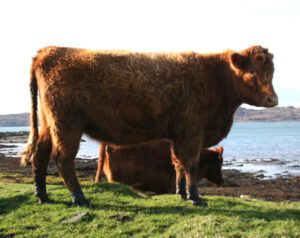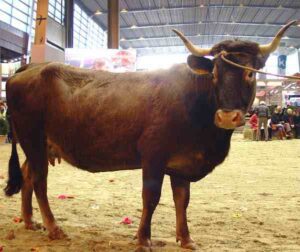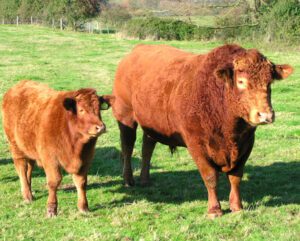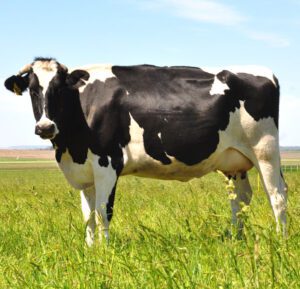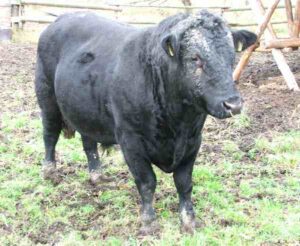The Shorthorn cattle are a dual purpose breed of cattle and suitable for both milk and meat production. The breed was originated in the 18th century from the North East of England.
Although the Shorthorn cattle breed was developed as a dual purpose animal, but certain blood lines within this breed always emphasized one quality or the another (either milk or meat). These different lines diverged over the time and two separate breeds had developed by the second half of the 20th century.
This two separate breeds are the Milking Shorthorn and the Beef Shorthorn. Usually all Shorthorn cattle are red, white or roan colored. Some people prefer the roan colored cattle, and completely white animals are usually not common.
But there is a Shorthorn type bred to be consistently white, which is known as the Whitebred Shorthorn. The Whitebred Shorthorn was developed for crossing with black Galloway cattle for producing a popular blue roan crossbreed. And that blue roan crossbreed is known as the Blue Grey.
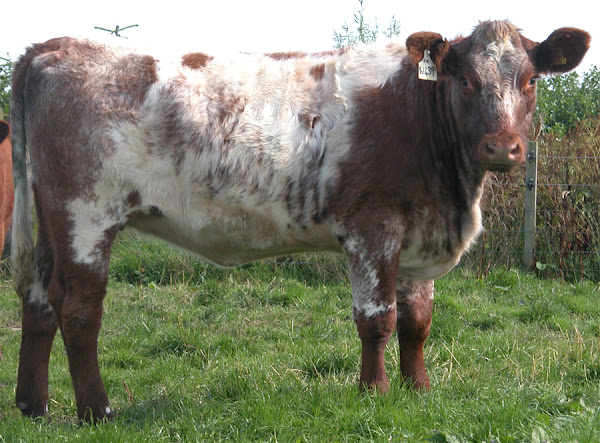
The original Shorthorn cattle breed was developed from Durham and Teeswater cattle found mainly in the North East of England. The Colling brothers, Charles and Robert started improving the Durham cattle using the selective breeding techniques in the late 18th century.
Robert Bakewell had used the same selective breeding techniques successfully on Longhorn cattle. Currently the Shorthorn cattle are widely distributed throughout the world. But they are mainly found in the English-speaking countries and South America.
They are mainly found in Zimbabwe, Uruguay, United States, United Kingdom, South Africa, Republic of Ireland, New Zealand, Argentina, Australia and Canada. However, read more information about this important English cattle breed below.
Shorthorn Cattle Characteristics
The Shorthorn cattle are large animals and usually with a mix of red, white or roan coat color. But there is a type of this breed which is consistently white. The animals are usually polled naturally.
Although some blood lines may have short horns, as their name suggests. The Beef Shorthorn cattle are bigger than the Milking Shorthorn. Feet and leg structure of these animals are good with very few problems.
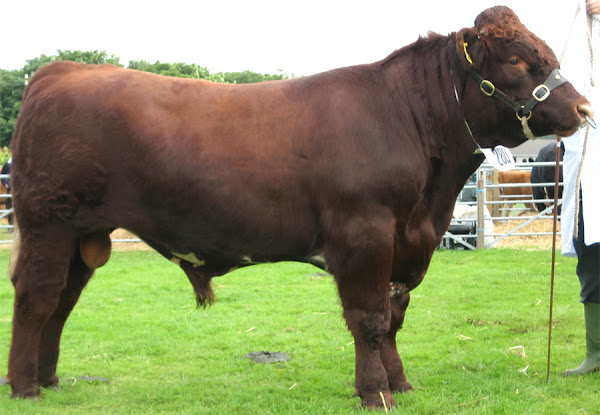
Average body weight of the Shorthorn bulls is around 1000 kg. And the cows on average weight around 800 kg. Photo and info from Wikipedia.
Uses
Shorthorn cattle were developed as a dual purpose animal. They are among the good dual purpose cattle breeds which are good for both milk and meat production. Although, certain blood lines within the breed always emphasized one quality or the other, either milk or meat.
Special Notes
The Shorthorn cattle are very well adapted to a wide range of climatic conditions. They have great longevity, and this feature helps the farmers not to worry about the cost of head replacements.
In case of temperament, the Shorthorn cattle are docile and very easy to handle. Their pleasant temperament is ideal for the small farmers. They are usually very hardy and have good disease-resistance and immune systems which are essential for keeping a healthy herd
They are very good and natural grazers. And they can convert feed to milk and meat with great efficiency.
The Shorthorn cows are very good milk producers. On average they produce around 8000 kg of milk per lactation, and their milk also has a decent ratio of protein against fat.
In case of meat production, the Shorthorn cattle are also very good. They are popular for their weight gain efficiency and suitability for low input system. However, review full breed profile of this breed in the following table.
| Breed Name | Shorthorn |
| Other Name | None |
| Breed Purpose | Milk, Meat |
| Special Notes | Hardy, strong, fast growers, well adapted to a wide variety of climatic conditions, excellent grazing abilities, very easy to handle |
| Breed Size | Heavy |
| Bulls | Around 1000 kg |
| Cows | Around 800 kg |
| Climate Tolerance | All Climates |
| Coat Color | Mainly red, white or roan |
| Horned | Yes/polled |
| Milk Yield | Good |
| Rarity | Common |
| Country/Place of Origin | England |


